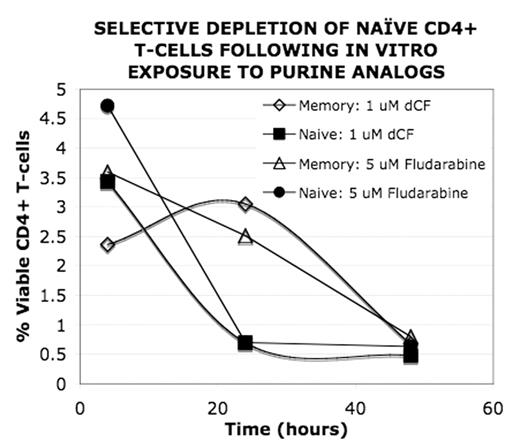Abstract
Background: Nucleoside analogs have potent anti-tumor activity, especially against lymphoid malignancies, with immuno-suppression being a significant toxicity. We have previously described the immunosuppressive effects of fludarabine on murine T-cells, and found selective cytotoxicity against naïve subsets that reduced their allo-reactivity in a GvHD model of murine BMT (Giver et al 2003 BBMT 9:616). In this study we tested the cytotoxicity of fludarabine and pentostatin against human and murine T-cell subsets to determine their immune-suppressive activity, mechanism of action, and their potential utility as agents to decrease the allo-reactivity of allogeneic donor lymphocyte infusions.
Methods: Peripheral blood mononuclear cell samples from normal donors were incubated ex vivo ex vivo treatment with Flu at doses of 5, 50, and 250 mcg/ml or pentostatin at doses of 1, 10, and 100 mcg/ml at 0, 4, 24, and 48-hour time points following 1 or 24 hour drug exposure. All samples that obtained dCF also received 25 mcg/ml of deoxyadenosine (dAdo), which enables dCF to mediate cytotoxicity against lymphocytes. Control samples for fludarabine and pentostatin treatment were untreated or treated with dAdo only, respectively. The total number of viable cells and the fractions of the CD4 and CD8 memory and naive T cell subsets that survived nucleoside exposure were determined by multi-parameter flow cytometry following staining with antibodies to CD3, CD4, CD8, CD45RA, CD6L, Annexin, and 7-AAD.
Results: The decrease in the viability of the human naïve CD4 T cells, whether treated with fludarabine or pentostatin, was rapid and most notably observed after the 24-hour time point. On the other hand, the human memory CD4 T cells displayed a more gradual decline in percent viability in both treatment with fludarabine and pentostatin. Furthermore, the potency of pentostatin was exhibited in that it achieved a comparable effect to fludarabine while at substantially lower doses. Data obtained from the murine model also demonstrated a relative a relative sensitivity of the CD4 naïve T cells as oppesed to the CD4 memory to purine analog exposure.
Conclusions: Future work will determine the optimal dosage and period of incubation for pentostatin and fludarabine that can utilized to induce immunosuppresion ex vivo in donor lymphocytes.
SELECTIVE DEPLETION OF NAÏVE CD4+ T-CELLS FOLLOWING IN VITRO EXPOSURE TO PURINE ANALOGS
SELECTIVE DEPLETION OF NAÏVE CD4+ T-CELLS FOLLOWING IN VITRO EXPOSURE TO PURINE ANALOGS
Disclosure: No relevant conflicts of interest to declare.
Author notes
Corresponding author


This feature is available to Subscribers Only
Sign In or Create an Account Close Modal